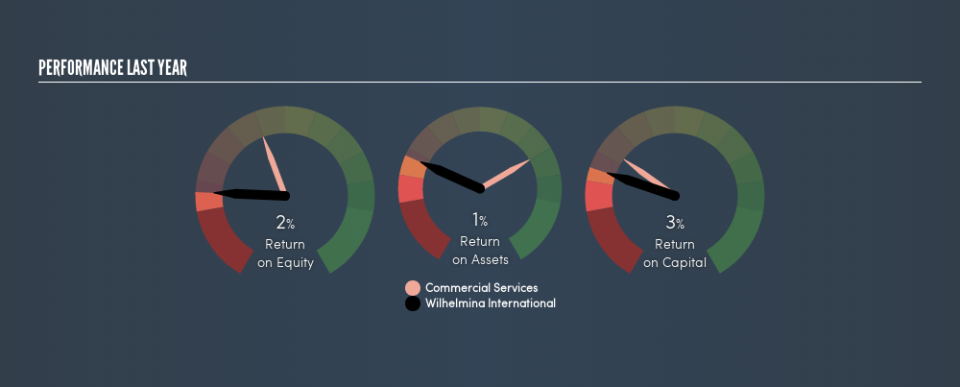Why You Should Care About Wilhelmina International, Inc.’s (NASDAQ:WHLM) Low Return On Capital

Today we'll look at Wilhelmina International, Inc. (NASDAQ:WHLM) and reflect on its potential as an investment. Specifically, we're going to calculate its Return On Capital Employed (ROCE), in the hopes of getting some insight into the business.
First up, we'll look at what ROCE is and how we calculate it. Then we'll compare its ROCE to similar companies. Finally, we'll look at how its current liabilities affect its ROCE.
What is Return On Capital Employed (ROCE)?
ROCE is a measure of a company's yearly pre-tax profit (its return), relative to the capital employed in the business. In general, businesses with a higher ROCE are usually better quality. Ultimately, it is a useful but imperfect metric. Renowned investment researcher Michael Mauboussin has suggested that a high ROCE can indicate that 'one dollar invested in the company generates value of more than one dollar'.
How Do You Calculate Return On Capital Employed?
The formula for calculating the return on capital employed is:
Return on Capital Employed = Earnings Before Interest and Tax (EBIT) ÷ (Total Assets - Current Liabilities)
Or for Wilhelmina International:
0.034 = US$1.0m ÷ (US$46m - US$16m) (Based on the trailing twelve months to March 2019.)
So, Wilhelmina International has an ROCE of 3.4%.
Want to participate in a short research study? Help shape the future of investing tools and you could win a $250 gift card!
View our latest analysis for Wilhelmina International
Is Wilhelmina International's ROCE Good?
When making comparisons between similar businesses, investors may find ROCE useful. In this analysis, Wilhelmina International's ROCE appears meaningfully below the 11% average reported by the Commercial Services industry. This could be seen as a negative, as it suggests some competitors may be employing their capital more efficiently. Regardless of how Wilhelmina International stacks up against its industry, its ROCE in absolute terms is quite low (especially compared to a bank account). There are potentially more appealing investments elsewhere.
Wilhelmina International's current ROCE of 3.4% is lower than 3 years ago, when the company reported a 5.5% ROCE. Therefore we wonder if the company is facing new headwinds.
When considering this metric, keep in mind that it is backwards looking, and not necessarily predictive. Companies in cyclical industries can be difficult to understand using ROCE, as returns typically look high during boom times, and low during busts. This is because ROCE only looks at one year, instead of considering returns across a whole cycle. You can check if Wilhelmina International has cyclical profits by looking at this free graph of past earnings, revenue and cash flow.
How Wilhelmina International's Current Liabilities Impact Its ROCE
Current liabilities include invoices, such as supplier payments, short-term debt, or a tax bill, that need to be paid within 12 months. The ROCE equation subtracts current liabilities from capital employed, so a company with a lot of current liabilities appears to have less capital employed, and a higher ROCE than otherwise. To counteract this, we check if a company has high current liabilities, relative to its total assets.
Wilhelmina International has total assets of US$46m and current liabilities of US$16m. Therefore its current liabilities are equivalent to approximately 35% of its total assets. Wilhelmina International has a medium level of current liabilities (boosting the ROCE somewhat), and a low ROCE.
What We Can Learn From Wilhelmina International's ROCE
This company may not be the most attractive investment prospect. Of course, you might find a fantastic investment by looking at a few good candidates. So take a peek at this free list of companies with modest (or no) debt, trading on a P/E below 20.
I will like Wilhelmina International better if I see some big insider buys. While we wait, check out this free list of growing companies with considerable, recent, insider buying.
We aim to bring you long-term focused research analysis driven by fundamental data. Note that our analysis may not factor in the latest price-sensitive company announcements or qualitative material.
If you spot an error that warrants correction, please contact the editor at editorial-team@simplywallst.com. This article by Simply Wall St is general in nature. It does not constitute a recommendation to buy or sell any stock, and does not take account of your objectives, or your financial situation. Simply Wall St has no position in the stocks mentioned. Thank you for reading.

